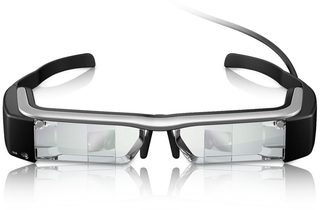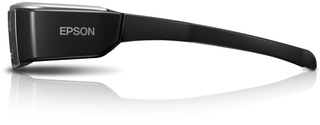Epson Moverio BT-200 Augmented Reality Glasses Review
Epson proves that Augmented Reality is here and starting to deliver on its promise. The Moverio 200 glasses are far from perfect, however, and the applications are just emerging.

Hands-On With Epson's Augmented Reality Glasses
Epson's Moverio 200 augmented reality glasses were one of the first commercially shipping binocular models when they arrived earlier this year, giving the company at least one distinct advantage. There are development tools and loads of developers, an app store, a modest handful of applications, and even customers for the $700 product. In other words, they work. It's real.
So far, however, the applications for the Moverio 200 predict an experience that is more practical than it is fun, which will disappoint those who wish the equation were skewed in the opposite direction. There is probably a future where you can superimpose digital games into your analog world and vice versa, one where the very nature of gaming will be reimagined, fluid and ubiquitous, in a very real sense of that word. But that particular future hasn't emerged yet. We've seen only its underpinnings, the precepts and concepts that will stir the imagination of developers and creators. Building blocks, only. Truth be told, even the practical side of augmented reality still needs work. The good news is that it's just a matter of time.
The future of augmented reality is perhaps the more interesting part, but we've been down that road already. This is a gut check on the present, through the literal lens of one product, from one company with both the marketing clout and technology know-how. It's time to focus on how well Epson has executed. Some companies had to be the early pioneers here, and by virtue of its long-standing strengths in projection technology, Epson has jumped to the forefront, boldly and bravely, but also naked and exposed.

The short version is that several weeks with the Moverio 200 glasses were fun, filled with several aha moments, a few mesmerizing experiences and a pretty firm understanding of what will be possible. I played games, I used test applications meant to give me a sense of the possibilities in the real world and I performed normal, everyday Web tasks through the glasses.
Those experiences were all unique compared to the two-dimensional experiences we have all come to expect from our digital devices, and therefore they were infinitely more interesting. Yet none of them beckoned me back with addiction. The most I could say is that everything made perfect sense.
Additionally, I wish there were more applications, particularly some with greater consumer appeal. I slowly began to realize that augmented reality will first see broad usage in very specific, vertical business industries like equipment repair, field work for insurance adjusters or retail auditors. Epson is seeing usage in guided training, remote support, mining, oil and gas, transportation, construction and more -- any place where the glasses can help overlay contextual information onto a real-world scenario. And that's fine, and probably better than fine because that's where this technology will earn its keep and its funding, and from there find its way to the rest of us. But I'm impatient and I want it now.

An Epson spokesman said that the company estimates its developer base in the thousands based on its developer program. While many of those developers are creating enterprise-oriented applications, Epson has seen an uptick in consumer apps being uploaded for review for the Moverio Apps Market, just launched weeks ago. The company expects hundreds of apps by the end of 2014, the spokesman said. There are fewer than 50 as of this writing.
Stay on the Cutting Edge
Join the experts who read Tom's Hardware for the inside track on enthusiast PC tech news — and have for over 25 years. We'll send breaking news and in-depth reviews of CPUs, GPUs, AI, maker hardware and more straight to your inbox.
The spokesman also said that Epson's customer base is actually 60% enterprise and 40% consumers, which is a more recent shift. One of the biggest uses are for first-person views of drone flights, where a pilot needs to maintain line of sight with the drone but also view telemetry data and live video feed of what the drone camera captures.
You can see the practicality of that, but it's no killer app.
There's something else, though. After some extensive use of the Moverio 200, it still seems as if the technology powering the actual glasses is still in the proverbial stone ages of our admittedly time-lapsed digital evolution. The brains and the circulatory system of the Moverio 200 sit in a control unit that would be vastly improved if it were today's cheapest commercial smartphone, rather than the brick of a device it is right now. I struggled with it mightily.

In truth, it is a controller in name only. It's really neither a controller nor a smartphone. It succeeds at neither, and I wish Epson had just chosen one or the other. It plods along with a TI OMAP 4460 1.2GHz dual-core processor running Android 4.0. We ran a benchmark or two on it just for fun, but its score isn't worth printing. The pad is small and rough, and moving between screens, or selecting items, or holding and moving objects within an app or around the OS is an exercise in frustration. Even after weeks of use, I found myself struggling to move between Android screens and menus, let alone manipulate something inside an app or scroll down a webpage.

The glasses, too, are bulky. We've all seen these and scoffed at them, even the lightweight Google Glass. The Moverio 200s, because they are binocular, are bigger and uglier. If you're inside of a repair shop, that's not such a big deal. But even for that application, I would want them lighter and more flexible. It's not just about looks, after all, but comfort and convenience. Those are not attributes of these glasses. The glasses weigh 88 grams, which is nearly 3x the weight of the monocular Google Glass, just for comparison.

The other aspect, of course, is resolution. The Moverio 200 are 960x540, so we're not talking about stunning visual imagery here. You can find more of the exact specs below, but my particular experience is predictably fuzzy. Everything is fairly clear and visible, but a little less so around the edges. The bulk of the glasses sometimes made it harder for my eyes to create a single image. Occasionally, after lengthy usage — watching videos or building things — I would experience a slight dizziness, despite the lack of full immersion (the real world context of augmented reality should reduce or eliminate this). Some of this could just be me.
It's also worth noting that Epson's nosepiece can be removed, allowing you to slip the glasses on over prescription glasses. The Moverios also come with sunglass inserts, and I tested these outside on a few sunny Los Angeles days to great effect.

Finally, a word about battery life. The 2720mAh battery is rated at six hours, and for the most part that's close to what I experienced, without doing any extensive battery-draining benchmarks. However, one day I just watched YouTube videos in succession (yes, it's a tough life I live) and the battery drained in less than two hours. While an Epson spokesman said that watching straight video will run down the battery more quickly, the two hour mark was a bit of a surprise.
Current page: Hands-On With Epson's Augmented Reality Glasses
Next Page The Competition And Technical Specifications-
usertests If I buy into AR glasses, it would be what Vuzix is doing, with the entire lenses as a display, or with an image projected directly onto the retina. AR apps that can cover your entire FOV are more useful, and Google Glass's corner display causes eye strain.Reply -
qlum In other words this may be released but its still a proof of concept far away from any practical use.Reply -
dgingeri I want an app for these that would show a realtime map centered around my location in the upper right corner, like the minimap from WoW, and show me pop up names for people I work with over their heads so I can be reminded of people's names.Reply -
AR Dirt You may be interested in the only Podcast dedicated to the world of AR. Go to www.ARdirt.com/ourapp to learn how to download the podcast app for free. You can get it on iOS, Google Play, Amazon App store and Windows phones.Reply
Most Popular


